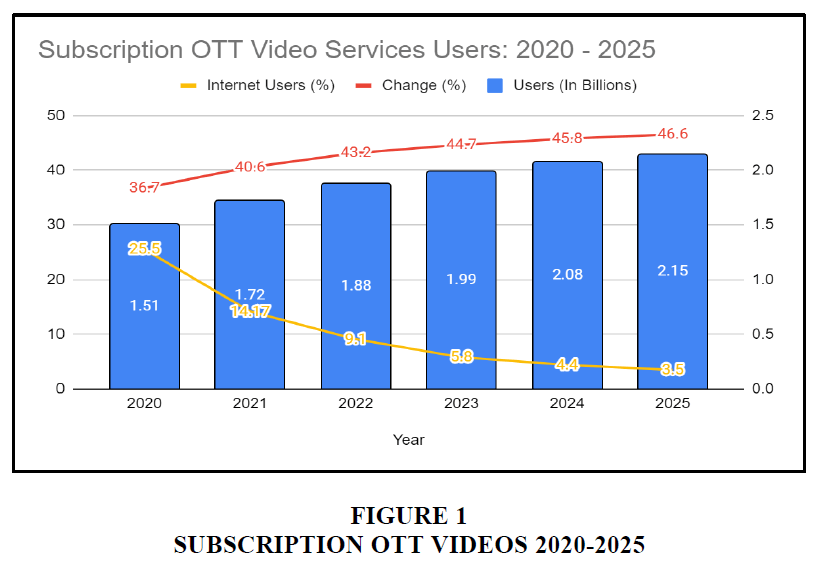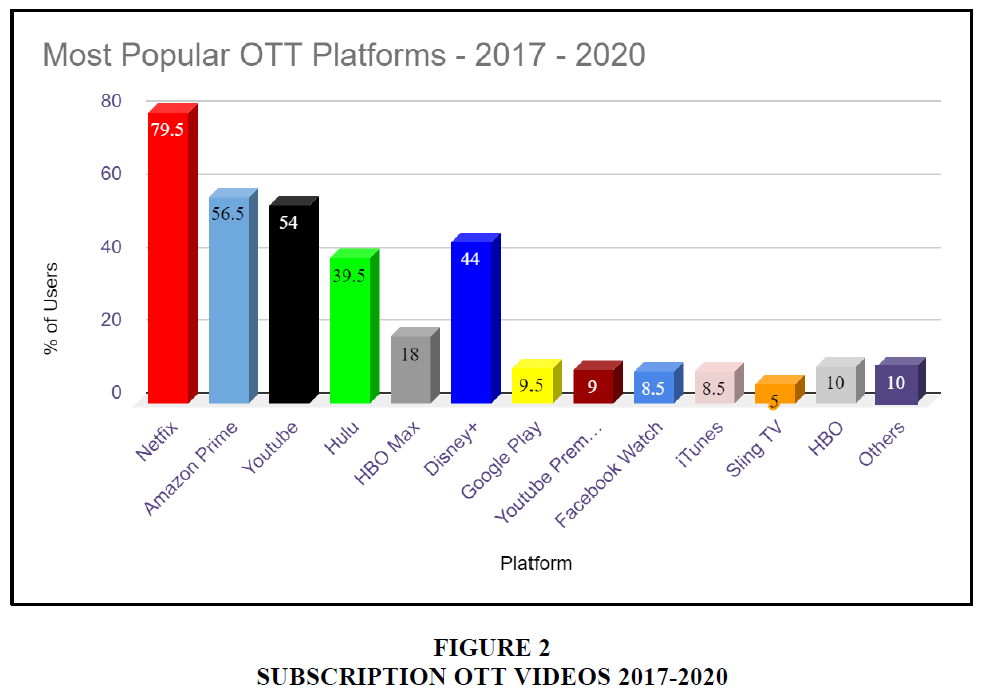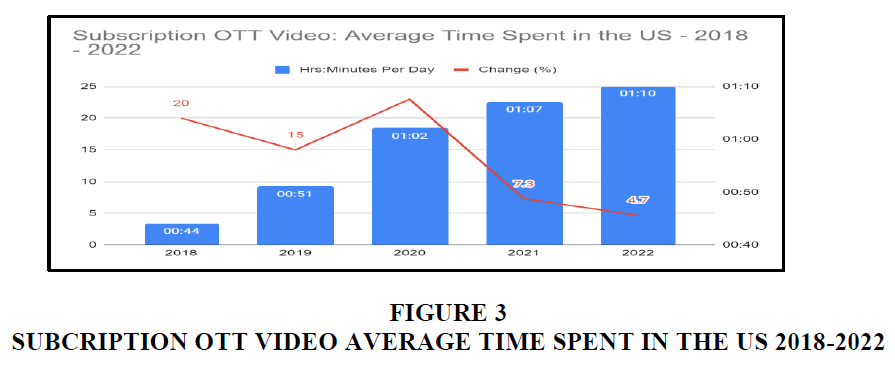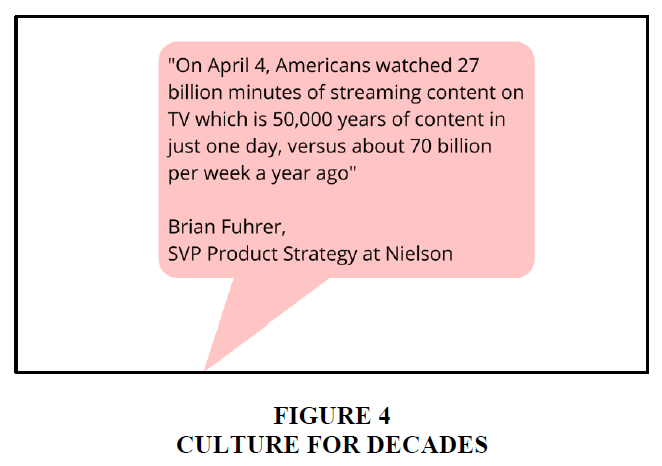Short commentary: 2022 Vol: 26 Issue: 5
The Impact of Ott Platforms on the Short Film Genre
Sharan Gupta, Beyond Codes Inc., Simi Valley, CA
Citation Information: Gupta, S. (2022). The Impact of ott Platforms on the short film genre. Academy of Marketing Studies Journal, 26(5), 1-6.
Abstract
Short films have always been there but in the last few years, the craving for the format has increased. The main reason for its popularity is the variety for the audience and a learning experience for the filmmakers. Platforms like Netflix and Vimeo are the most influential participants in the business, catering to movie makers across the world. For millennials, short films are a way to learn and for the experts, it is a way to explore. OTT platforms have emerged stronger than ever since 2020 and that is because of the freedom it provides for filmmakers to explore global genres bypassing the commercially burdensome processes of the industry. The audience is looking to explore new, woke and informed content, they are tapping into global industries to connect with the contents, characters, and the ideas that hold a mirror to the society. The short film industry provides a myriad of genres and ideas that are focused on connecting with the audience and keeping them engaged for twenty to forty minutes. This article explores the impact of the OTT platforms on the short film categories and the opportunities, and value it has created in the industry. It will also discuss the importance of OTT platforms, their regulations and the growing demand for the new content. We will also look at some global industry data and analyse investment trends in the OTT space.
Keywords
OTT, Anthology, Short Films, Film Industry, Movie Makers, Cinema
Introduction
An Increasing Appetite For Short Film Category
“But short films are not inferior, just different. I think the short gives freedom to filmmakers. What's appealing is that you don't have as much responsibility for storytelling and plot. They can be more like a portrait, or a poem.” Jane Campion, Film Director, Screenwriter and an Academy Award Winner Banerjee et al. (2021).
Covid 19, US Election 2020, killing of George Floyd, Black Lives Matter movement, death of Bollywood actor Shusant Singh Rajput, invasion of Ukraine, Palestinian housing crisis, Taliban takeover of Afghanistan and the war in Yemen are some of the international events that triggered Bentley et al. (2019) a major response from the netizens of the world. Mass movement and social dissatisfaction have spread across the world like wildfire and created a massive need to capture the events unfolding Jain (2021).
Technological advancements and smartphones with HD cameras have generated a vision for social justice and a cry for help in the form of short films. The short films that have sprung over the last few years have addressed the problems of police brutality, the perversion seen through democratic elections, and national lockdowns and their effect on the blue-collar workers Jaiswal et al. (2022).
Hence the appetite for short films is not specifically focused on the plot per se but rather on an idea. Short film-makers have been proven to be more relevant, vocal, and versatile than long features Mastrini & Krakowiak (2021).
With the pace of events in the world that are unfolding, it requires an immediate response and representation so that the events make more sense Palomba (2022). The Russian invasion of Ukraine is one example, which took place in February 2022, and has garnered attention worldwide. The short films related to the event can already be found on many platforms. Creators from around the world have released short films like, “No To War”, “Breaking Point: The War on Democracy”, “Cyborg”, “No obvious Signs” and countless more.
The Creators and Directors
Who is making short films and why? What are the major streaming platforms and why?
The Figure 1 below shows MCU’s (Marvel Cinematic Universe) plans for phase four. By the end of 2022, all of these movies and TV series will be released for the world to soak up the glory of superheroes and super villains. The average production budget for these is betwixt $200 million to $300 million. Filmmakers, studios and production houses make the most money from these high grossing movies Rao (2021). In 2021, the global box office revenue added up to 21.3 billion dollars, a little more than half of 42.3 billion dollars in 2019, before the covid outbreak. These revenues mostly come from the commercially successful movies with glamour, state of the art sets, best VFX and a pile of popular actors. Without going into the much larger conversation of Art films vs commercial films, it is an established fact and in the name itself that commercial movies make the most money. With this logic, everyone would want to make commercial films and earn a little more for that second farmhouse in the hills or the beach. So why make short films? Sadana & Sharma (2021).
Short films are a gateway. They are the magic door that opens up to a large selection of genres, techniques and cutting edge technology. The filmmakers benefit the most from the short films. Not in terms of revenue but rather with experience and exposure Saha (2021).
The normal ambit for a short film leads it to be screened at film festivals. Being selected for it is itself a bonanza for the film, but it also allows filmmakers the advantage of showcasing their talent without having to splurge the money that most of them don’t have Sahu et al. (2021).
Have you heard of “The Big Shave”? Maybe not!
Before Martin Scorsese became one of the greatest directors in the industry, he began his journey with the short film, The Big Shave. Before Taika Watiti directed Marvel movies and won an Oscar for Jojo Rabbit, there was “Two Cars, One Night”. Christopher Nolan is known around the world, and he got his start with a short film, “Doodlebug” in 1997.
The point of sharing these one line memoirs is that the greatest filmmakers around the world got recognition by trying something new, providing mind-altering narratives and by turning their “crazy” ideas into short films. These are the people who are making short films. The students, the dreamers and the great filmmakers of the future.
Short Film Streaming
You probably know what a streaming platform is; by definition, it is an on-demand online source of entertainment and media. For Example, youtube, Netflix, Hulu, Hotstar, amazon prime videos, Vimeo, sundance now and countless more. So how do the streaming platforms help content creators?
Reels and short video formats have taken a big leap thanks to TikTok, Instagram, Snapchat and Facebook. These platforms are not the traditional streaming platforms but they have become the forum for the content creators around the world. Short movies are often released by newcomers and amateur directors on these platforms. So why is that?
These platforms have a massive user base, quality metrics, analytics and a huge platform for gathering your audience. These platforms help the filmmakers market their films and talent. The metrics to earn money from them is very low.
When you google “what are the best platforms to watch short films?” the lists show Netflix, Youtube, Vimeo and Sofy.TV at the top. These platforms are the major platforms to stream short films and film-makers from across the world have exhibited their talents on them across genres.
The next question that comes to mind is if they make any money. If you are not selling your movie to Netflix, Amazon or others, the chances of making money off your short film completely depend on your marketing skills. Creators have been monetizing through Youtube and Vimeo. These platforms can pay a small percentage of money for a certain number of views.
Importance of OTT (Over-the-top) Platforms
Have you heard of “Netflix and Chill”?
It’s a euphemism for hanging out and watching a movie/show!
OTT has become a part of the culture of all generations. It is available for everyone in the world with access to the internet. Its content changes with demography, it’s updated periodically and new content role out in the blink of an eye!
We are living in the era of amazing films and mind-blowing TV shows. If the last decades were about multiplexes and theatres, the coming decade will be about the OTT content. When the 2020 Covid pandemic hit, the theatres and movie halls, were all closed, so everyone in the world turned to OTT to look out for new content to take a break from daily monotony.+
The pandemic acted as an incendiary for the OTT platforms. The subscriber growth was up to 60% in a very short time. This is also when the OTT platforms started exploring bigger markets and started investing heavily in new content Figure 1.
Over the last 3 years, Netflix, Amazon Prime, Disney+Hotstar, Zee and SonyLive, have invested heavily in creating content in India, based on various vernaculars across the country. Shows like Family Man, Sacred Games, Mirzapur, Rocket Boys and Scam 1992, immediately attracted the subscribers to the OTT. And yes, that is how the OTT platforms make money. They depend on the subscriber to pay a monthly fee, which can be from $10 to $20 per month depending on the platforms. Many OTT platforms earn money through ads and subscribers but the mainstream platforms like Netflix, Amazon Prime Video and Disney+Hotstar do not display advertisements on their streaming platforms Figure 2.
Over the years, the amount of content consumed and the hours spent on the OTT platform have increased dramatically. The binge-watching culture, Netflix and chill, or just a Saturday night movie hang, has become a daily routine. Current figures state that the average time spent on OTT platforms in the US alone as increased by 23% by 2020. OTT subscriptions skyrocketed in India as brands like Disney+Hotstar, Amazon Prime and Netflix have reported an uptick of 65%.
Almost fifty million households subscribe to OTT and there is a huge number that shares their password. Even after having a great number of subscribers, some OTT platforms are still facing problems and have low revenue coming up. The reason for low revenue is password sharing and since there are no advertisements, subscriptions are the major source of revenue for the OTT platforms Figure 3.
As we have covered the basics of OTT, and its reach, let's conclude by stating its importance. Every day, the world is becoming more sensitive to the needs of everyone, these platforms are telling stories of the ones forgotten, reaching the audience that needs a little sensitivity and providing opportunities for actors, directors, and filmmakers to explore different ideas and genres to present it to the world. OTT has become a large part of our culture. It is important for the artist, for the audience, it gives us a chance to break from our reality and live in the fantastic world of sitcoms, horror movies, psychological thrillers, happy families, crazy families, and the friends who live across the hall and many more. OTT has not only created new content but it has also brought back the shows from the past, that have been part of the pop culture for decades Figure 4.
Conclusion
We have discussed the short films, their importance and where to watch them in this article. The popularity of OTT platforms has impacted the short film genres by opening them to the audience, which would not have found its way to them otherwise. Most short films have a small budget, amateur but ambitious film-makers, and actors looking for that one break, and it halts, even at the best at Film Festivals. The short films until, a few years back were limited to a small portion of the audience, who would come across them while streaming random videos on Youtube. Monetizing from them was not an option, as the viewership was very small. The OTT platforms have begun to host a myriad of short films, across all the genres, this has helped the filmmakers, to aim for bigger investments and sell the movies on OTT platforms. This has encouraged short film-makers to explore and deliver quality content. The journey doesn’t just stop at the film festivals. OTT along with social media has helped artist advertise their work and reach larger audiences. The promotions from mobile phone companies like Apple, One Plus and Samsung, who have encouraged artists to use their devices to make films, have added to the bonus. The impact is large!
The world is smaller than ever, we are all connected within the reach. There is no corner of the world where social media and OTT platforms have not made an impact. Short films are reaching a wider audience, they are telling the stories of human emotions, relationships, government, wars and everything in between.
At the end of the article, we have listed some websites and short films which are worth looking into to understand the art and impact of OTT in the short film genre.
References
Banerjee, S., Hameed, N., & Sukumar, A. (2021). Female power in women centric tamil films on ott platform amazon prime. Mass Communicator: International Journal of Communication Studies, 15(1), 27-32.
Indexed at, Google Scholar, Cross Ref
Bentley, F., Silverman, M., & Bica, M. (2019). Exploring online video watching behaviors. In Proceedings of the 2019 ACM International Conference on Interactive Experiences for TV and Online Video (pp. 108-117).
Jain, M. K. (2021). The Rise of OTT Platform: Changing Consumer Preferences. EPRA International Journal of Multidisciplinary Research (IJMR), 7(6), 257-261.
Jaiswal, S. N., & More, N. S. (2022). OTT Platforms-its future scope and regulation in India.
Mastrini, G., & Krakowiak, F. (2021). Netflix in Argentina: Accelerated expansion and little local production. Comunicación y Sociedad (0188-252X), 18.
Palomba, A. (2022). Building OTT brand loyalty and brand equity: Impact of original series on OTT services. Telematics and Informatics, 66, 101733.
Indexed at, Google Scholar, Cross Ref
Rao, H. (2021). Impact of OTT Giants On Video Entertainment Preferences of Indian Young Adults: A Before and After Study (Doctoral dissertation, Syracuse University).
Sadana, M., & Sharma, D. (2021). How over-the-top (OTT) platforms engage young consumers over traditional pay television service? An analysis of changing consumer preferences and gamification. Young Consumers.
Indexed at, Google Scholar, Cross Ref
Saha, S. (2021). Consumption pattern of OTT platforms in India. International Journal of Modern Agriculture, 10(2), 641-655.
Sahu, G., Gaur, L., & Singh, G. (2021). Applying niche and gratification theory approach to examine the users' indulgence towards over-the-top platforms and conventional TV. Telematics and Informatics, 65, 101713.
Indexed at, Google Scholar, Cross Ref
Received: 09-Jun-2022, Manuscript No. AMSJ-22-12163; Editor assigned: 12-Jun-2022, PreQC No. AMSJ-22-12163(PQ); Reviewed: 27-Jun-2022, QC No. AMSJ-22-12163; Revised: 04-Jul-2022, Manuscript No. AMSJ-22-12163(R); Published: 15-Jul-2022



